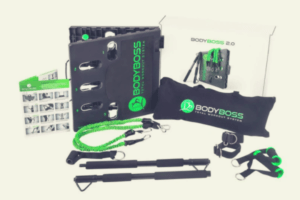If you are in a hurry and just want to find out what the best vertical jump trainer for explosive leg power, then I’d recommend the Figrol Jump Trainer as the best one.
When you see someone doing an amazing jump, it is tempting to ascribe their achievement to good genetics.
Most people seem to think that jump height is some kind of magical attribute that cannot be altered.
Thankfully, this is not the case. Let’s take a quick look at five of the best vertical jump trainer products on the market.
Here are the best vertical jump trainers we’ll be reviewing:
- SKLZ HOPZ Vertical Jump Trainer
- FIGROL Jump Trainer
- PER4M Jump Trainer
- INNSTAR Vertical Jump Trainer
- Wowelife Vertical Jump Trainer

Best Vertical Jump Trainer Buyer’s Guide
Before we look at these products and attempt to determine which is the best vertical jump trainer, let’s consider some of the things that you need to know before investing in this kind of equipment.
What Is A Vertical Jump Trainer?
If you’ve never heard of a vertical jump trainer, you might think that it’s a large and expensive piece of machinery.
However, nothing could be farther from the truth.
A jump trainer basically consists of a padded belt, a couple of bungee cords, and a pair of ankle straps.
The bungee cords are stretched between the belt and the ankle straps, creating strong resistance any time you extend your legs.
Unlike some other methods of resistance-based jump training, they do not require that you put any extra weight on your body.
The extra resistance causes your body to achieve a greater level of muscle activation.
Is A Vertical Jump Trainer Effective?
There seems to be a significant amount of evidence to show the effectiveness of this simple device.
For a start, let’s look at this study.
Two groups of athletes were given a nearly-identical training program.
The only difference between the two groups was the fact that one group also incorporated a jump trainer into their daily workout.
After twelve weeks, the jump-trained group showed a substantial increase in the height of their vertical jumps.
It should be noted that proper jump training requires a good benchmark. For most people, a basketball goal serves this purpose quite well.
Research has shown that jump training is more effective when someone has a goal for which to strive.
If you don’t have a basketball hoop, you can always just put a line of tape on the wall.
It should also be noted that you might need several weeks to obtain the kind of results you want.
The person in this video trained with the device for 8 weeks.
As you can see, he obtained quick improvements.
However, this was followed by a two-week plateau during which his jump height did not increase at all.
However, he obtained a pretty significant height increase in the end.
Price
In most cases, a vertical jump trainer should not be very expensive. We say this because a vertical jump trainer is not very hard to improvise.
Although it wouldn’t be optimal, a person could simply take some standard bungee cords (which normally have hooks on each end), hook one end to a belt, and hook the other end to your shoes.
Unless it has some serious extra features, a jump trainer isn’t worth a huge amount of money.
Safety Concerns
Any time you opt for resistance bands, you are accepting a small amount of risk.
We have never heard of anyone being killed by a malfunctioning resistance band; you can certainly hurt yourself if you aren’t careful.
For instance, take the guy in this video. He stretches his resistance bands to their absolute maximum, putting too much strain on them.
Before you feel sorry for this guy, think about the position into which he placed himself.
Because of the way in which he was holding the cords, it should have been obvious that he would end up taking a bungee right to the face.
The moral of the story is this: When using your resistance bands, always consider the possibility of breakage and take proper precautions.
When selecting a jump trainer, you probably don’t need to worry about getting whipped in the face.
However, getting whipped in the legs or the back is no picnic either. Make sure that your chosen model has thick bungee cords that are secured in place with durable steel clips.
Carabiners are good, but you can swap them out for quick links if you want some extra durability.
Comfort
As we mentioned earlier, a person could easily make an improvised vertical jump trainer, though it probably wouldn’t be the best vertical jump trainer.
To justify their cost, a device of this type should be very comfortable.
Until you actually wear the device, you might not realize that both the belt and the ankle straps will be under near-constant tension.
Thus, you need something that can be adjusted tightly. If not, there will be a lot of extraneous movement and possibly some chafing.
You will also lose some of the resistance if all the bands are not properly tightened. Because these straps have to be tight, padding is of utmost importance.
Portability
As a final note, we should mention the importance of portability. You will be more likely to use your jump trainer outside or at the gym.
Thus, it shouldn’t take up a lot of bag room. Try to find a trainer that can be rolled or folded into as small a package as possible.

Reviews of the Best Vertical Jump Trainers
SKLZ HOPZ Vertical Jump Trainer
The SKLZ HOPZ Vertical Jump Trainer is one of the more common brands and has a fairly trusted reputation. The belt portion is very well-padded, though the ankle straps aren’t quite as comfortable.
The ankle straps also have a bottom strap which goes under your foot. While this can cause some chafing issues, it also provides extra stability when properly tightened.
The main failing of this product is the way in which the cords attach to the belt and straps.
Rather than using a clip, this product uses a strange “sliding tab” system to lock the cords in place.
We do not believe that this locking system is reliable enough. On top of that, there doesn’t seem to be any convenient way to purchase replacement bands.
Pros
- Belt is well-padded
- Extra ankle strap adds stability
- Trusted name
- Belt and straps stay firmly in place
Cons
- Cords attach in a strange way
- Extra ankle strap can be uncomfortable
- No easy way to buy replacement bands
- Most expensive product on our list
FIGROL Jump Trainer
The FIGROL Jump Trainer is a pretty simple set that should require no instructions. The cords simply clip into place, and the belts use nothing but folded velcro.
If you can figure out a velcro shoe, you should have no trouble here.
We like well-wrapped cords like these because they grant an extra safety factor.
When the bungee breaks (as they all eventually do), a thick covering can prevent the cord from flying in random directions and causing injury.
At the same time, some customers complain that the bands will break too easily, and there also seems to be a distinct lack of padding on the inside of the belt.
Speaking of the belt, the D-rings that are used to anchor the cords seem as if they might not be strong enough to hold up over time.
However, this problem is easy to fix with a little sewing, and may not actually be a problem at all.
Pros
- Bungees clip on with ease
- Cords are well-wrapped
- Extra ankle strap
- 35 pounds of resistance
- Convenient carry bag
- Low cost
Cons
- D-ring connectors aren’t anchored well enough
- Not much padding inside the belt
- Some customers complain of easy band breakage
PER4M Jump Trainer
The PER4M Jump Trainer requires some instructions because of the weird way in which the belt attaches.
Sure, it isn’t rocket science, but it is needlessly complicated. Still, there are some good point as well.
This model has good thick cords and a very minimalistic design.
The junction points (where the cord and belts meet) of this device are covered, which adds to the comfort factor by preventing metal from rubbing against bare skin.
However, some points are lost for the ankle straps, which are too thin.
Pros
- Belt is very strong
- Extra ankle straps
- Cords are very thick
- junctions are covered to avoid chafing
- Comes with extra bands
Cons
- Carabiners are a little bit small
- Belt fastens in a strange and overcomplicated way
- Ankle straps are too thin
INNSTAR Vertical Jump Trainer
The first thing we notice about the INNSTAR Vertical Jump Trainer is how well-padded the ankle straps are.
These straps are very comfortable, and the foam is breathable so that it doesn’t cause discomfort on hot days.
However, there is a small piece of foam that protrudes from the top.
This piece of foam is not reinforced by anything else, and so it is likely to be destroyed under heavy use.
In terms of durability, this one looks great.
The stitching of the belt seems to be reinforced with multiple lines at every angle.
This means you can still use this belt even if one of the stitches fray or wear out. The cords are also reinforced with rubber and cloth coverings.
Pros
- Ankle straps are extremely well-padded
- Cords are covered
- Junctions are covered in thick plastic
- Belt stitching is well-reinforced
Cons
- Foam liner on ankle straps too fragile
- Bands need frequent re-adjustment
Wowelife Vertical Jump Trainer
Wowelife Vertical Jump Trainer is a very simple model, and seems to be pretty popular. All cords are strong and covered from end to end.
A cloth sleeve covers the rubber while thick rubber covers the ends. Because of its simple design, this one is really easy to adjust.
Portability is good on this model, as its parts are minimal in size and bulk.
On top of that, it also comes with a pair of attachable handles so that you can use the cords to exercise your arms as well.
Still, this is of secondary importance for those who want to improve their jump.
The main problem we see here is the width of the belt. It is just too thin, and this might cause it to dig into your waist when fully tightened.
This model also lacks a little bit in terms of padding. Neither the belt nor the ankle straps have the kind of thick layer that we want.
Pros
- Nice and simple
- Cords are thickly covered from end to end
- Easy to adjust
- Comes with handles for versatility
Cons
- Belt and straps aren’t well-padded
- Belt is too thin
- Handles are useless for our purposes
Final Thoughts
It is somewhat difficult to choose a winner here, as all of these products have their strengths and weaknesses.
Since these products are also very similar, our choice of the best vertical jump trainer will come down to the smaller details.
Overall, the Figrol Jump Trainer is the best vertical jump trainer.
While it was not free of problems, its flaws were minor ones in comparison to most other products on this list.
The SKLZ trainer almost got the win but lost significant points for the strange way in which the cords are attached.
The Figrol Jump Trainer offers durability, safety, a low cost, and ease of use.
It lacks just a little in the comfort and portability departments, but its advantages in other areas are more than enough to offset these issues.
We thank you for reading this article, and we hope you will be happy with whatever purchase you choose.










